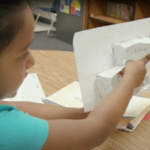 If we look back at the last two decades, we never could have anticipated the “internet of things.” We could not have predicted the impact of such a “market disruptor” and its effect on the twenty-first century. Yet now, with 20/20 hindsight, we can see how our lives have changed: our interactions, our culture, our politics, our society, our education, our youth, our business, our commerce… OMG, right?
If we look back at the last two decades, we never could have anticipated the “internet of things.” We could not have predicted the impact of such a “market disruptor” and its effect on the twenty-first century. Yet now, with 20/20 hindsight, we can see how our lives have changed: our interactions, our culture, our politics, our society, our education, our youth, our business, our commerce… OMG, right?
Do you remember those first years of automation? We built websites and acclimated to .coms. We also found ourselves running to our desks to instant message, write on Word, or send our first emails. If we call that Web 1, my gosh, by 2007, a few short years later came Web 2—a wholly new mobile universe. The new iPhone provided instant access to the internet. Our habits changed because with this innovation we were now, newly, in constant connection. Indeed, Twitter and Instagram blossomed in the same year.
With these new forms of social media, we started interfacing with all ages, all genders, and all races—globally—all the time. An unanticipated plethora of change unfolded dramatically in both good and bad ways. Indeed, this affected our workforce, presenting a new Gig economy, a new set of required skills in coding, software, cyber, and the transcendence of remote working… We have been on a rapid-fire trajectory, and change is not stopping. Is the Metaverse the Next Big Thing?
Metaverse Class and Leaders
These questions and more brought me to the Socrates program, put on by the Aspen Institute. I had the honor and privilege of attending The Metaverse and Me: The Implications of Living, Working and Playing in Alternate Realities from July 8 – 11.
Our illustrious leaders included Stephen Balkam, who is CEO of the Family Online Safety Institute (FOSI), whose mission is to create a culture of responsibility in the online world. He was awarded the Carl Bertelsmann Prize in Germany for Innovation and Responsibility in the Information Society, and he has spoken in 16 countries and 4 continents and written for the mainstream press, including the Wall Street Journal, the Washington Post, and the New York Times.
Our other class leader was Julie Owono. She is the Executive Director of the Content Policy & Society Lab (CPSL) and a fellow of the Program on Democracy and the Internet (PDI) at Stanford University. She is also one of the inaugural Directors of Facebook’s Oversight Board, as well as an affiliate at the Berkman Klein Center at Harvard University.
To be clear, I knew exactly nothing about the Metaverse. And I knew only little bits about Block Chain, Crypto, and the future of Web 3. But as I read and listened to so many sources, it became abundantly clear that the Metaverse was imminent.
In my Mentorship work and writings, I often observe the gaps between what educators teach and what the real world is looking for in their future employees. In taking this class, I had a primary goal to understand better what new skills would be required in developing the Metaverse.
Class Structure
Our class was structured in such a way that we would do readings and then be led in a Socratic Method of conversation. We would be invited to share opinions, divulge concerns, and compare reactions all in respectful dialogue. The attendees were represented by great diversity, age, gender, background, and locale.
In the first day’s reading, in his Framework of the Metaverse, Mathew Ball writes, “We can guess that the Metaverse will revolutionize nearly every industry and function. From healthcare payments, consumer products, entertainment, hourly labor, and even sex work. In addition, altogether new industries, marketplaces, and resources will be created to enable this future, as will novel types of skills, professions, and certifications. The collective value of these changes will be in the trillions.”
These readings set the stage for a logical progression of topics:
- Day One—the history of innovation and its transformation of our society,
- Day Two—projections of the Metaverse and its impacts, technology integration required to institute the Metaverse, the creative requirements, and values it will bring to our society,
- Day Three—Governance needed to keep guard rails aligned. Who is the citizenry, how do you join, and are there rules to participating? If so, what are the consequences?
Business Integration
The following business information on the Metaverse is extracted from “How to Make a Killing in the Metaverse” from the Darwin Investor Network.
To date, businesses are starting to adopt the Metaverse. Such as:
- Facebook, which changed its name to META and is focusing on the future of technology and multiple new media platforms.
- Microsoft is buying Activision Blizzard, a leading video developer with hundreds of millions of monthly users.
- Unity Software provides platforms for developers to create, run and monetize 2D and 3D content.
- NVIDIA designs graphic processing units used in personal computing, gaming, and mobile devices. They use the term “Omniverse” to refer to their technology.
- Cloudflare develops software for firewall, routing, traffic optimization, load balancing, and other services. Their new Distributed Web Gateway Project will be critical in supporting new technologies, and will likewise simplify Web 3 applications.
- Roblox is a free online gaming platform, with an in-game currency called “Robux.”
- Matterport provides a 3D data platform to design, build, promote and manage homes, offices, hotels, factories, and shops that are virtually replicated. They are in the business of digitizing physical assets.
Companies are innovating ahead of the curve. How can we keep up?
Takeaways
Besides thoroughly enjoying the 20 attendees and leadership of this class, I had many takeaways, and hopefully, some of this information will tickle your thinking, too. What is to come? How are we educating our next generation of Americans?
I’ll start with Mathew Ball’s definition of the Metaverse—especially for you readers who, like me, might be curious but don’t really know what the Metaverse is.
“The Metaverse is a massively scaled and interoperable network of real-time rendered 3D virtual worlds which can be experienced synchronously and persistently by an effectively unlimited number of users with an individual sense of presence, and with continuity of data, such as identity, history, entitlements, objects, communications, and payments.”
As one of the foremost experts and authors on Metaverse, Ball also describes 8 core categories that can be thought of as stacked, scaffolded, and interdependent:
- Hardware
- Networking
- Computing
- Virtual Platforms
- Interchange of Tools and Standards
- Payments
- Metaverse Content, Services, and Assets
- User Behaviors
For me, this brings to bear the many new talents and skills that will be required to deliver the Metaverse universally. It will be like transitioning from silent films to full-color “talky” movies. Unlike Web 2, which mainly falls into worldwide connectivity via words, information, data, media, and photo/video, Web 3 is 3D, and Experiential.
Therein lies a huge difference.
The many uses, both practical and playful, are so varied that we can only begin to anticipate them. Imagine 3D-styled education and training, where medical schools and surgery are practiced through 3D operations. Imagine gaming that utilizes military-style strategies and response mechanisms. Or maybe socially networked interactions with self-made avatars who embark together on new worlds.
In fact, I recently toured a newly designed and built home with a friend who, in planning her layout, experienced the metaverse. How? Her architect gave her a Virtual Reality headset, which allowed her to tour the house and walk through the plans virtually, in 3D. In each room, she could virtually experience the functionality and flow of the architect’s design.
Or imagine an advertising campaign that takes you into a new world, but instead of using the ubiquitous brochure or website, you have a virtual experience of skiing in Saudi Arabia—before you ever fly there.
And what if you could participate in a virtual Halloween, where you slip on a completely new identity—possibly that of an animal, a different gender, a talking plant? Spielberg would have a hay day! The possibilities are absolutely infinite, wondrous, and imminently scary.
One thing is for certain: our educators and the future of technology need to get on the bandwagon. We need to prepare our youth for the future of work, and the Next Big Thing. If the past is any indicator of the future, hold on to your hats!
To that end, I sat at the close of class with a tech media writer to identify the new kinds of jobs and what they are called, so that I could help my newsletter readers consider expanding their course load and educational offerings. Here’s the list we came up with:
- Hardware Design
- Usability Testing
- User UXpense Design
- Augmented and Virtual Applications
- Coding Python and Swift
- Visual Design, 3D, 2D, AIA, Digital
- Headset Innovation
- Monitoring-Usage
As I passed around a questionnaire to the class about the Skills Necessary in the Metaverse, I also received many Soft Skill suggestions including:
- Teamwork
- Community Development
- Empathy
- Global Growth Mindset
- Critical Thinking
- Innovation
- Collaboration
- Understanding the role of Governance and Regulation
I’m delighted to share my few days diving deep into the future and gaining a better understanding of what it might hold. I’m hoping this brief summary will entice you to read more and share your findings—especially identifying how the Metaverse will change the future of work—so we can best prepare our next generation. And it goes without saying that this applies to far more than just educators. Technology-based mentors, let’s see what you can bring to the classroom! I am certain you will have a captive audience.


